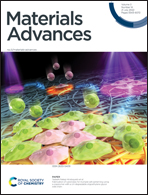Electrochemical detection of Pb(ii) and Cd(ii) using bismuth ferrite nanoparticle modified carbon paste electrodes
Abstract
This study presents bismuth ferrite nanoparticle (BFO) modified carbon paste electrodes (BFO/CPEs) for the determination of lead and cadmium. XRD and FT-IR spectroscopy were used to characterize the bismuth ferrite nanoparticles synthesized following the procedure described in the Experimental section. Cyclic voltammetry was used to evaluate the electrochemical behavior of the two metals at the modified electrode relative to the unmodified electrode. In contrast to the unmodified carbon paste electrode, the BFO/CPE within the potential range of −1.2 V to 0.0 V vs. Ag/AgCl revealed distinct and undistorted peaks, with a much enhanced peak current showing the electrocatalytic properties of films that may be accounted for the increased conductivity and surface area of the BFO. Under optimized conditions, the differential pulse stripping voltammetric peak current response of the BFO/CPE showed a linear dependence on the concentration in the range of 2–200 μM with limits of detection of 0.03 μM and 0.05 μM for Pb(II) and Cd(II), respectively. Spike recovery results of 90.4–102.4% for Pb(II) validated the applicability of the method for the determination of Pb(II) and Cd(II) in tap water samples.



 Please wait while we load your content...
Please wait while we load your content...